OILY SKIN AND ACNE
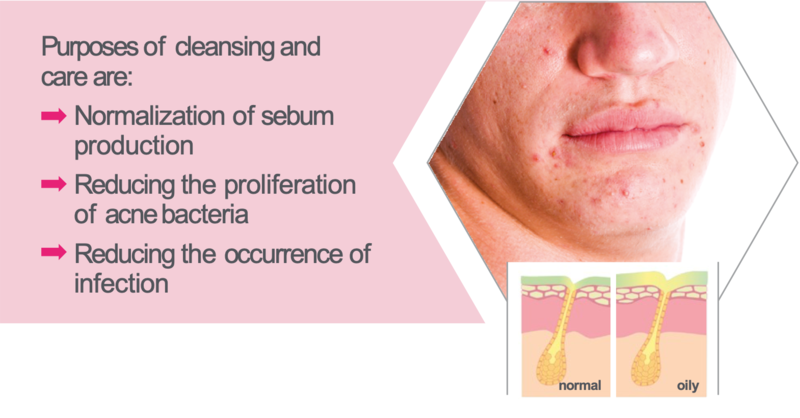
- Most common skin condition in puberty
- Skin’s appearance: large pores and oily film on the surface
- Skin is shiny, thick and tough
- Impurities consist of open and closed comedones (blackheads and whiteheads)
Purposes of cleansing and care are:
- Normalization of sebum production
- Reducing the proliferation of acne bacteria
- Reducing the occurrence of infection
Oily skin is most common during puberty. Due to the hormonal changes (especially androgens) all glands show increased activity - including the sebaceous and sweat glands. The result is a hydrolipid film with very high concentrations of lipids which makes the skin shine.
Men tend to have oilier skin than women. This condition may last to the age of 40. In many cases the oily areas form in the T-zone typically found in combination skin.
The skin is thick, pale and whitish with large pores and blackheads. Blackheads (comedones) are clogged follicles. Various substances, such as mineral oil or lanolin, as well as creams rich in oils, have a comedogenic effect. These substances or preparations should not be used in the care of oily skin in any way.
The positive side of oily skin is that it is also tough and strong. The skin’s resistance is apparent, for example, in the alkali neutralization capacity and the lower sensitivity to irritants.
Recommendations: Gentle cleansing of the skin with a mild syndet is important. Excess oil and loose corneocytes are removed and by stabilizing the pH to 5.5, the growth of pathogenic bacteria and fungi is inhibited. Swelling of the skin can be avoided and sebum can flow better. A clarifying facial toner removes excess sebum.
Additional care effects are achieved with an anti-inflammatory, soothing gel (e.g. Aloe barbadensis, Allantoin, Panthenol). Also, supplementing the care with a moisturizing product is important (e.g. Hyaluronic acid).
NORMAL SKIN / COMBINATION SKIN
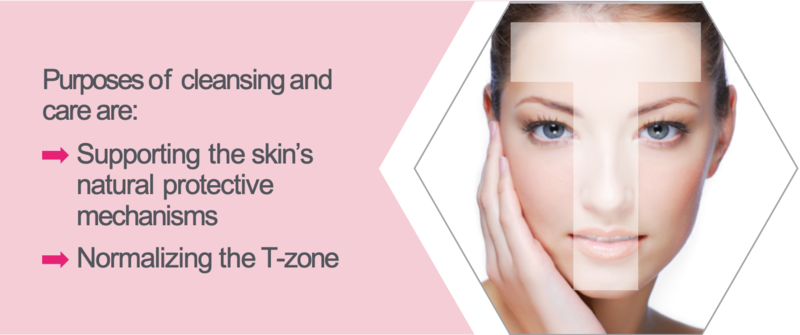
Normal skin is the ideal: healthy, taut, rosy, with good circulation and fine pores
Combination skin has two faces:
- Normal to dry skin on the cheeks and around the eyes and mouth
- Oily skin on the forehead, nose and chin
Purposes of cleansing and care are:
- Supporting the skin’s natural protective mechanisms
- Normalizing the T-zone
Normal skin is the ideal condition of the skin and occurs most often in younger persons. The skin is soft, with fine pores, there is good circulation and it is firm and healthy looking - usually a condition without disorders or problems. There is a balance between moisture and sebum production. However, even with this optimal skin condition, external influences cause problems and affect the hydrolipid film, the barrier function or the acid mantle in their effectiveness.
Combination skin usually refers to skin that is normal or even dry on the cheeks and around the eyes and rather oily with impurities such as blackheads on the forehead, nose and chin (T-zone).
Recommendations: Care that is suitable for normal skin is often also effective for younger persons. The area of the T-zone can be treated with a clarifying skin toner after cleansing with a mild soap-free cleansing foam or
syndet which removes excess sebum. For treatment after washing, a moisturizing cream with pH 5.5 is suitable. The natural defense mechanisms - hydrolipid film, acid mantle and epidermal barrier - are sustained.
From the mid-30s onward, combination skin should be cared for with products that are adapted to the skin’s condition on the different areas of the face.
SENSITIVE, PROBLEMATIC SKIN
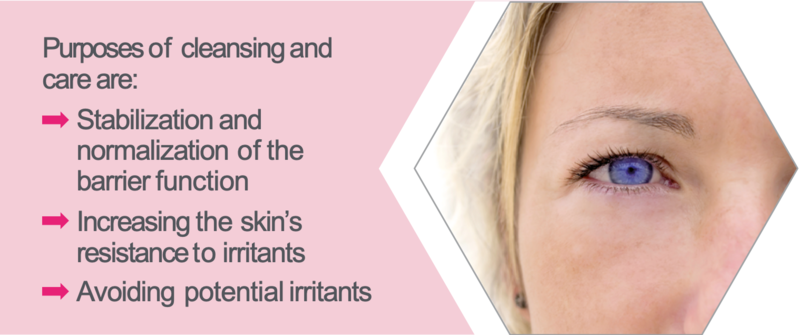
- Strong reactions to minor irritation
- Increased reactiveness to external and internal factors
- Affects the entire skin or individual regions
Purposes of cleansing and care are:
- Stabilization and normalization of the barrier function
- Increasing the skin’s resistance to irritants
- Avoiding potential irritants
Sensitive skin is a problematic skin condition as the skin reacts to various irritants - even very minor ones. Triggers can be internal or external factors, such as nervous tension, mental stress, illness or improper care, the climate or UV radiation. Increased sensitivity can occur in all skin conditions, but it is more common in dry skin than in normal or oily skin because of the lower barrier function.
Often a sensation of skin tension redness and flaking of the skin occurs after washing, showering or bathing. Itching, pimples and hives, mostly in connection with the use of improper cleansing or care products can occur as well. If the irritation occurs immediately after the application, it can be an unspecific irritation or an allergy of the immediate type (Type I). If the reaction occurs with a delay of several hours or 1 - 2 days after skin contact, then it is a delayed-type (Type IV) allergy. A burning sensation in the face after the use of personal care products which usually subsides after 10 to 20 minutes is known as “stinging”.
Sensitivity of the skin can - but doesn’t always - lead to disease. Seborrhoeic dermatitis, perioral dermatitis or polymorphic light dermatoses are typical examples of this. Certain skin diseases are also associated with increased sensitivity (e.g. atopic eczema). The recovery from an acute phase is very slow, so increased sensitivity can persist for several weeks.
Recommendations: When cleansing it is important that the skin should not be irritated or dried out. For this purpose a mild cleansing product with a pH value of 5.5 is used. The skin should not be rubbed but dabbed dry only.
Skin care products should be designed to introduce both moisture and lipids into the skin. Again, the pH value of
5.5 provides for a better stability and resistance of the acid mantle. Together with high quality ingredients, this results in a good tolerability and efficacy. Special soothing additives such as Camomile extract and Allantoin are also used.
DRY SKIN
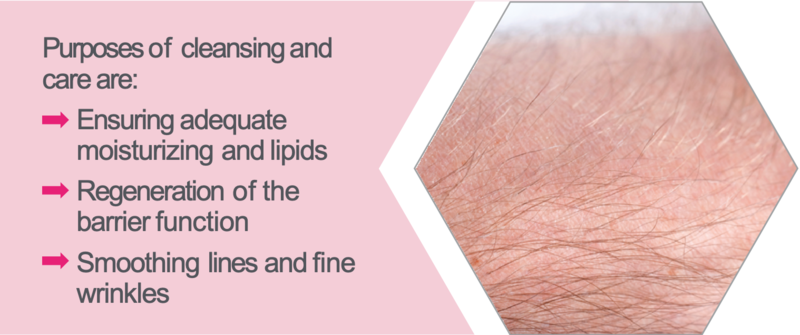
- Rough, reddened, thin skin with lines and fine wrinkles
- Symptoms such as tightness or itching
- Disturbed barrier function, easily irritated
Purposes of cleansing and care are:
- Ensuring adequate moisturizing and lipids
- Regeneration of the barrier function
- Smoothing lines and fine wrinkles
Dry skin can be caused by genetic predisposition or acquired. Often dry skin is accompanied by a sebostase, meaning that sebum production is reduced. Visually, the skin seems very thin and rough with rather fine pores. It appears somewhat transparent and is sensitive to physical and chemical irritants.
Due to the reduced production of sebum, the barrier function is impaired. This results in an increased transepidermal water loss. A lack of moisture in the Stratum corneum is characteristic.
The skin may be affected as a whole or the affliction limited to individual areas. Often the feet are especially afflicted. The area around the heel has a thick horny layer to protect from greater pressure and this tears through stress or impact. These are ideal entry points for bacteria and fungi and this often leads to painful inflammation.
Dry skin develops in almost all humans no later than the age of 60, a condition caused by a decline in the regenerative capacity of endogenous lipids and natural moisturizing factors.
Recommendations: Cleansing and care goals are the regeneration of the acid mantle and the hydrolipid film, as well as sufficiently supplying the skin with moisture and lipids in order to smooth it again.
In addition to gentle cleansing with soap-free products at pH 5.5, special skin care is needed. For dry skin, oils such as Avocado Oil and anti-inflammatory Phytosterols are recommended to prevent irritation, itching and tension. By stabilizing the skin barrier, they act to counter dehydration and external irritants.
VERY DRY SKIN
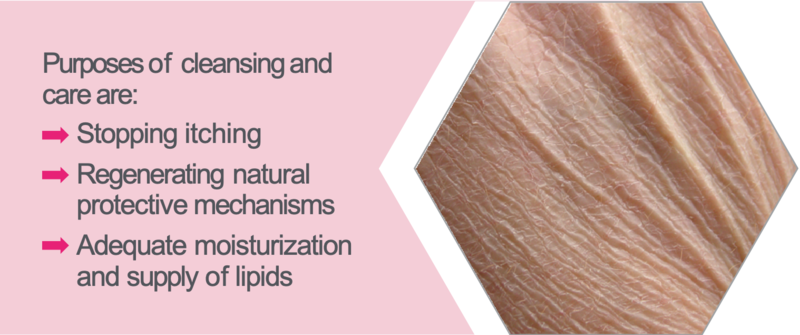
- Skin condition that manifests itself clinically in a rough, sometimes scaly, inelastic skin (xeroderma)
- Skin‘s appearance is very wrinkled
- Typical symptoms are itching and erythema, stinging, inflammation and fissures
Purposes of cleansing and care are:
- Stopping itching
- Regenerating natural protective mechanisms
- Adequate moisturization and supply of lipids
Very dry skin (xerosis or xeroderma) may be through genetic predisposition or acquired. Causes can be mental, physical, or chemical stress, hormonal changes, or diseases such as eczema, psoriasis and diabetes.
Characteristic is severe dehydration in the Stratum corneum caused by an impaired barrier function with increased transepidermal water loss or impaired differentiation of the keratinocytes and a lack of natural moisturizing factors.
Clinically, the condition is characterized by rough, scaly, partially keratinized and rather inelastic skin. There may be fissures. The skin is dull and wrinkled. Typical symptoms include itching, burning and a sensation of tightness of the skin. Since the protective mechanisms are disrupted, it can easily lead to infection or inflammation.
Acute inflammation should be treated with appropriate therapeutic measures. To alleviate the suffering of those affected, consistent therapeutic care must be effected.
Recommendations: As a measure against acute itching urea-containing products that penetrate quickly and bring moisture into the skin are recommended (not on acute eczema or wounds). In addition, Urea has a smoothing effect on the skin.
Urea has optimum stability at a pH of 6.2 and decomposes slowly outside this range to ammonia which shifts the pH to an alkaline value. Urea-containing skin care products cannot be adjusted to the pH value of 5.5. Therefore it is important that the daily cleansing and care be based on products with pH 5.5 to stabilize the skin barrier.
For basic dry skin care, active ingredients such as Omega-6 fatty acids are recommended. These regenerate the epidermal barrier structures and alleviate redness and roughness. Above all, Phytosterols are used to avoid
skin irritation, itching and tension. In addition, other active ingredients such as unsaturated fatty acids are used to regenerate the epidermal barrier structures and alleviate redness and roughness.
MATURE SKIN
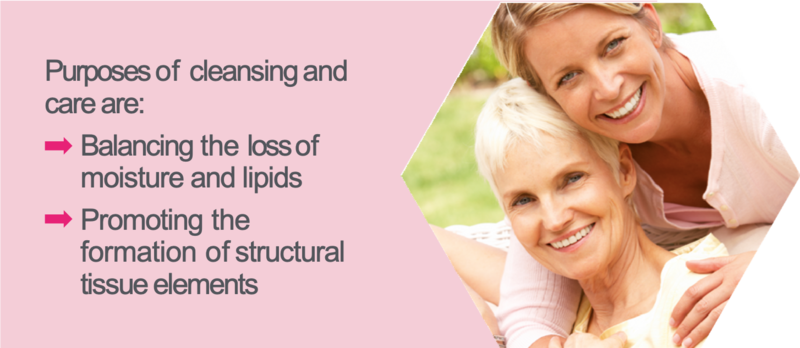
- With increasing age, the skin is affected by reduced metabolic activity, reduced regeneration, poorer circulation and reduced immune functions
- Typical signs are a lower elasticity, lines and wrinkles and age spots
- Further signs are dryness and increased sensitivity
Purposes of cleansing and care are:
- Balancing the loss of moisture and lipids
- Promoting the formation of structural tissue elements
Our skin starts ageing as early as the mid-20s and from the age of 30 we see the first signs of wrinkles around the eyes. We speak of mature skin at the onset of the hormonal changes occurring in menopause. It develops through a natural ageing process that progresses slowly. Women are affected about 10 years earlier than men, but men’s skin then tends to age more quickly.
In natural skin ageing, the skin becomes drier and less oily. Due to decreased metabolic activity, lower circulation and a simultaneous flattening of the papillary layer, the supply of the basal cell layer and the regenerative capacity is reduced. The activity of the sebaceous glands is reduced, the hydrolipid film and protective acid mantle loose stability and the immune functions of the skin decrease: the skin becomes more sensitive. Uneven pigmentation results in age spots.
The structure in the dermis changes, a reduction in metabolic activity of fibroblasts leads to less new collagen fibers being formed, existing fibers break or become attached to one another so that the mechanical strength and resistance decreases. There are fewer elastic fibers and thereby a loss of elasticity occurs - wrinkles appear.
At the same time the number and size of water-binding glycosaminoglycans drops, the cell pressure in the dermis diminishes and the skin droops visibly.
Recommendations: The consistent use of products with a pH value of 5.5 supports the protective acid mantle.
A mild soap-free cleansing is the foundation of good skin care. Cleansed skin is better able to absorb special ingredients. Antioxidants such as Coenzyme Q10 or Vitamin A, which also supports the activity of the fibroblasts can be used.
The deficiency of oil and moisture must be corrected to stabilize the epidermal lipid structures and retain moisture in the skin. The skin becomes smooth again. Specifically, Hyaluronic acid is used in order to moisturize the skin and protect it from further evaporation with a film of moisture.
HAIR CARE
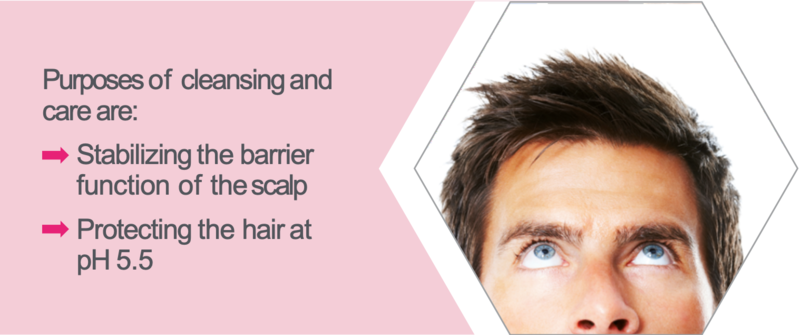
- The most dense hair is normally found on the scalp
- Finer hair covers the entire body
- The scalp‘s condition affects the hair
Purposes of cleansing and care are:
- Stabilizing the barrier function of the scalp
- Protecting the hair at pH 5.5
Different types of hair covers our bodies.
The highest density of hair is normally present on the head with about 300 - 900 pigmented hairs per square centimeter. This is known as terminal hair which grows at differing rates depending on gender, age, nutrition, general health or genetic factors. Women’s hair is comprised to about 35 % of terminal hair while men’s is comprised to between 20 % and 90 % depending on the influence of testosterone. In addition to hair on the head, there is hair in the armpits, groin, chest and legs.
In contrast to terminal hair, the vellus (downy) is very fine, non-pigmented hair covering the body surface.
Healthy, well-groomed hair on the head is synonymous with well-being and self-awareness. Healthy hair only grows on a healthy scalp. By stabilizing the skin’s barrier in the area of the scalp, irritation can be avoided which can lead to an overproduction of sebum.
Besides the use of lukewarm water for washing, the pH of hair care products is of great importance. The structure of hair, composed of a fibrous protein (keratin) is particularly stable at a pH of 5.5. Electrostatic charging and excessively dry hair can be avoided by using a mild, slightly acidic shampoo.
Shampoos with a pH of 5.5 are therefore not only beneficial for the scalp but also provide protection and care for the hair structure.
BABY SKIN / CHILDREN’S SKIN
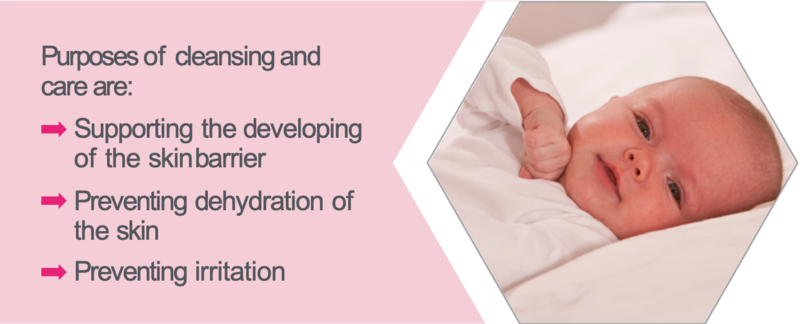
- Much thinner than the skin of adults
- Less dense meshwork of corneocytes
- Lower activity of sebaceous glands
- An immature acid mantle
Purposes of cleansing and care are:
- Supporting the developing of the skin barrier
- Preventing dehydration of the skin
- Preventing irritation
Baby and children‘s skin is considered a sensitive skin condition. While the skin is completely formed at birth, its structure differs significantly from adult skin: baby skin is only about one-fifth as thick as the skin of an adult. Only in puberty does the skin develop to the fully mature structure and function.
The separation between the individual cells in the Stratum corneum is larger. Permeability is increased and foreign substances and germs can penetrate the skin more easily.
The transepidermal water loss is greater and additionally the ratio of body surface area to weight is very high so that water loss and environmental influences have a greater impact.
The activity of the sebaceous glands is not fully developed so that the acid mantle and the hydrolipid film are not yet stable. At birth, the pH value is 6.5 and decreases during the first days to weeks. The baby‘s skin has a reduced alkali neutralization capacity and the immune system of the skin is still immature. The skin is most sensitive during the first years.
Temperature regulation is not fully developed until the age of 3. Only then the child‘s skin can regulate the body’s temperature.
Recommendations: In the baby’s first weeks, cleansing with lukewarm water suffices for the most part. If necessary cleansing can also take place with a mild syndet based on pH 5.5 - or baby oil can be used to remove dirt and excrements. According to dermatologists a baby should not be bathed more than once or twice weekly. To compensate for the lack of activity of the sebaceous glands, it is useful to apply cream to the skin after washing or bathing. Optimal care protects the skin from drying out and contains moisturizing as well as emollient substances.
The effect occurs immediately upon application. In cold weather an oily cream for protecting the face (which cannotyet protect itself) is important.
Children should by no means be exposed to the sun without appropriate protection during the first years of life. Even when they are older, constant sun protection is required.
